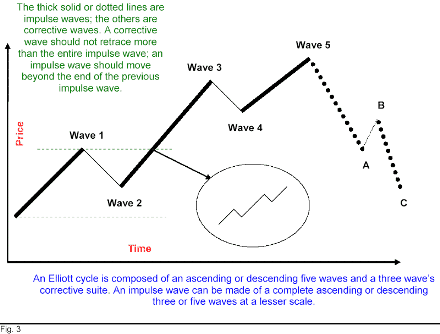Elliott waves are based on a study of market behaviour from R.N. Elliott. His theory was not as complex as the rules derived from it by modern technical analysis. Generally the market will move in cycles and Elliott postulates that a cycle is made of a rising trend of five waves followed by a corrective move of three waves, hence an eight waves cycle. Within each of these waves, you will have a smaller cycle that will repeat itself. This is called the fractal theory and it says that the patterns are replicating from a small scale to a larger. An example of decomposition of waves for a complete cycle would be 5-3-5-3-5-5-3-5, read 5 waves followed by 3 waves and on. To make it easier to follow a simple graph will describe what Elliott Waves and its typical patterns are:

Knowing the waves pattern in itself would not be of great help if it was not for the complementary knowledge brought by Fibonacci, an Italian mathematician from Pisa. Although he lived in a very different era, his contribution is enormous to the use of Elliott Waves. He postulated that there was a proportion or ratio that applied to natural phenomenon which he called the golden ration. He proceeded to prove it with calculations and a list of numbers came out.
These numbers are 1,1, 2, 3, 5, 8, 13, 21, 34 and so on. Each number is the sum of the previous two and in addition corresponds to the previous number times the golden ratio, in other words times 1.618. When applied to the waves, this theory enables the projection of price and time objectives for the market behaviour. Modern technicians have established relationships between the different waves of the cycle and elaborated rules and probability calculations. This set makes use of these rules and accepted relationships between the eight waves of a cycle. In addition, it will monitor 4 different cycles to enable you to trade different timeframes and risk levels.
Next: Elliott Waves - Basic Principle
Summary: Index